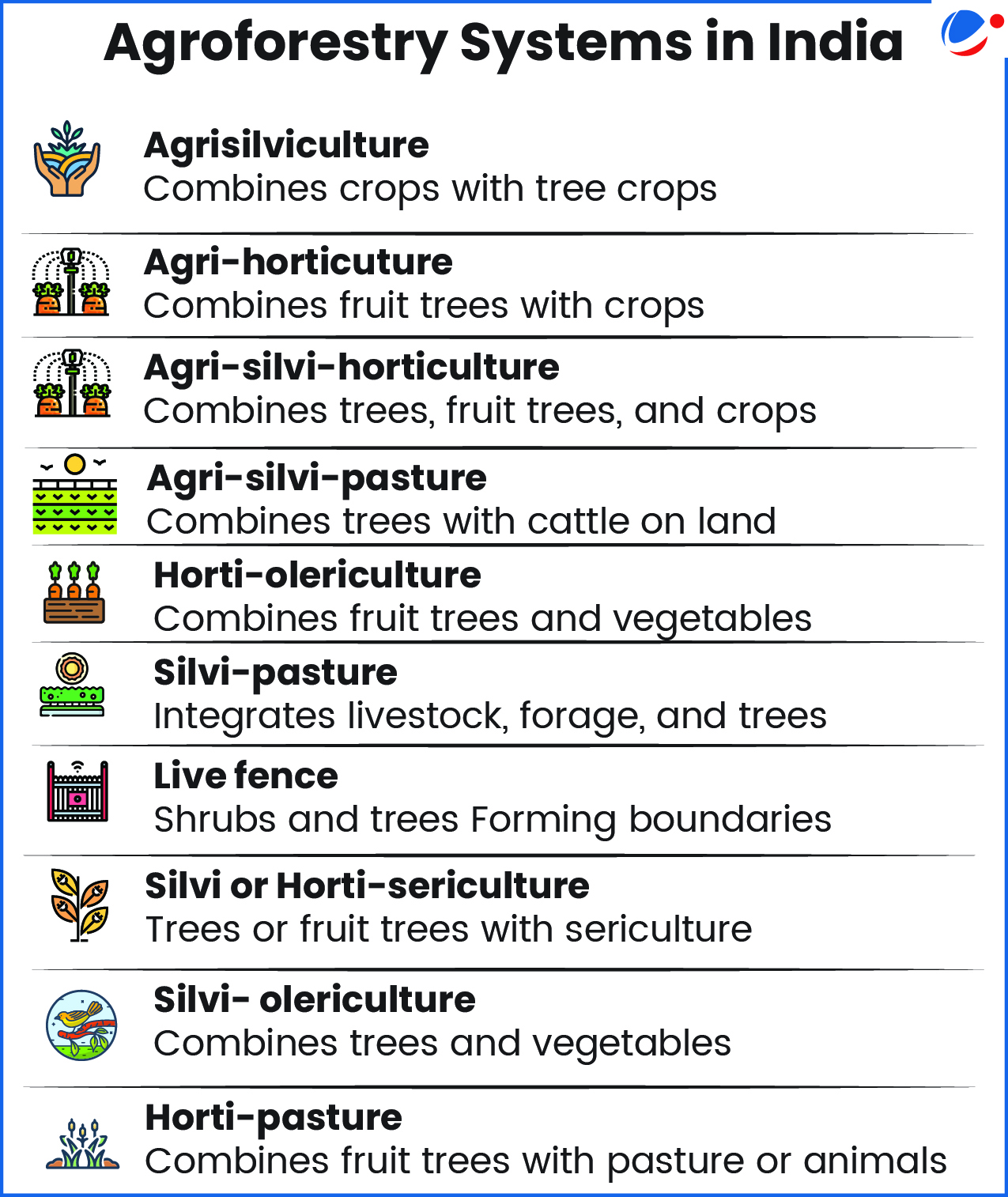
Why in the News?
The Government has issued Model Rules 2025 for the felling of trees on agricultural land in a bid to promote agroforestry.
More about the News
- The Model Rules include:
- The procedures for the registration of land for agroforestry.
- The felling of trees under agroforestry.
- The certification/transit of timber produced from agroforestry.
About Agroforestry in India
- According to National Agroforestry Policy 2014, "Agroforestry is defined as a land use system which integrates trees and shrubs on farmlands and rural landscapes to enhance productivity, profitability, diversity and ecosystem sustainability."
- The 2014 policy aims to encourage tree planting on farmland in a way that complements crops and livestock.
- India's agroforestry plantations occupy approximately 8% of India's geographical land area.
Significance of Agroforestry (EAC-PM Working Paper on Agroforestry)
- Agricultural Growth: It can help achieve the 4% sustained growth in agriculture.
- Diverse Impact: It provides almost half of the demand for fuelwood, 60% of raw material for paper and pulp, and 9 to 11% of India's green fodder requirement of livestock.
- Food Security: It increases agricultural yield (by an average of 51 percent) and check crop failure.
- It will improve nutrition, health, stabilization and improvement of communities.
- Sustainable Development:
- Carbon sequestration: It can sequester between 13.7 to 27.2 tonnes of CO2 per hectare per year.
- Soil Health: It improves soil's organic carbon content (SOC) concentration. E.g. From 0.62% of wheat and green gram to 1.14% under the poplar trees. It also reduces soil salinity.
- Climate Smart Agriculture: It can withstand extreme weather events, such as floods, etc.
- Environmental: It will reduce pressure on natural forests, more efficient recycling of nutrients, and better protection of ecological systems and reduction of surface run-off, nutrient leaching and soil erosion.
- Trees Outside Forest: Agroforestry can significantly contribute to increase in Trees Outside Forest.
- Others: Employment generation, reduction in imports and promote self-reliance for furniture and construction industry.
Challenges to develop Agroforestry
- Gaps in the policy:
- There is lack of information on the selected trees due to absence of Agroforestry tree manual for farmers.
- There is less emphasis on unique and hi-tech agroforestry systems like aqua forestry.
- Restrictive Regulations: Cumbersome process in obtaining permit, imposition of taxes at various stages of processing.
- Underutilization of India's National Transit Pass System (NTPS): An online transit passes generation system for inter-state and intra-state transportation of timber, bamboo, etc.
- Herein, 82% applications have been received only from 3 states/UTs i.e West Bengal, Telangana and Jammu and Kashmir.
- Availability of High Variety seeds: There is shortage of superior planting material and improved seed varieties.
- Bottleneck in Previous Policies: This resulted in over emphasis on few species like Poplar, Eucalyptus, Kadam etc. which were not much suitable to India's climate and soil. For instance, Eucalyptus is highly water intensive.
- Others: Absence of marketing infrastructure, lack of institutional finance and insurance coverage, etc.
Conclusion
There is a need for simplification of laws, better utilization of NTPS and introduction of Next Generation Systems to balance profitability, production and environmental footprint.



